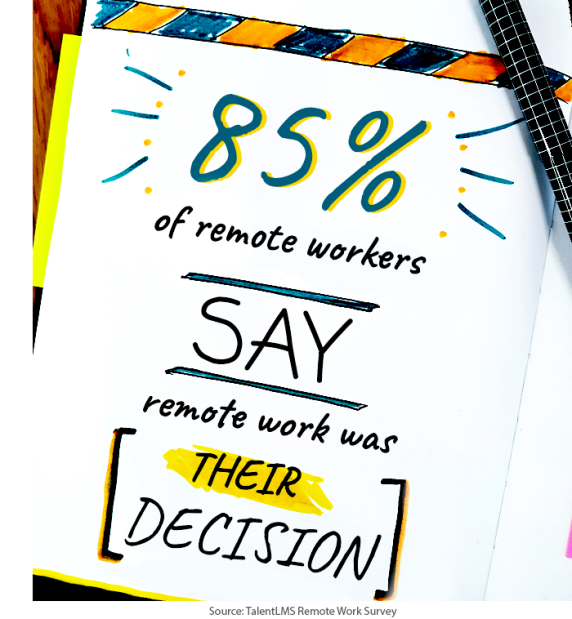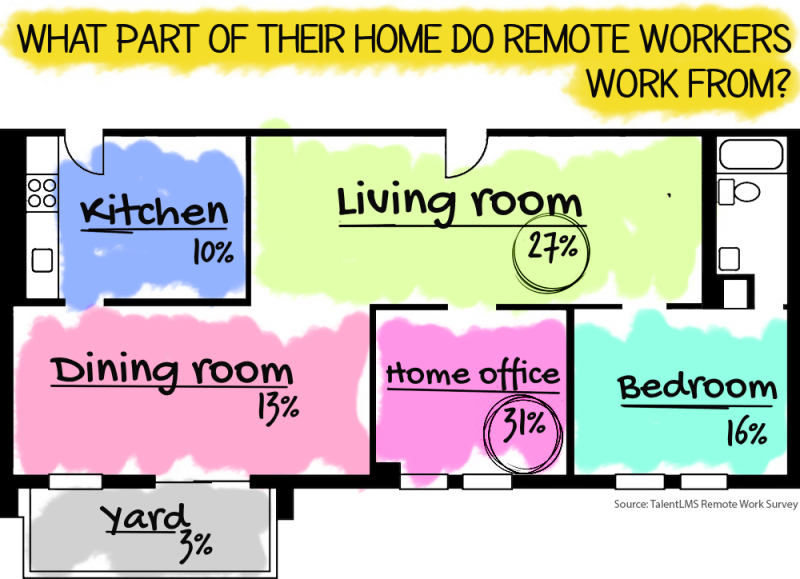The latest on all kinds of information, news, and resources that help you make working remotely better.
5 Ways Natural Light Improves Productivity | Henry Martin, Thebossmagazine.com

While companies all over the world are implementing a range of innovative perks, the overriding benefit on employees’ wish lists is quite simply: natural light.
Here are five ways natural light can improve productivity:
1. Improves sleep
Research carried out by Northwestern University of Chicago showed that employees who worked in an office with windows slept for an average of 46 minutes more every night than those who worked in offices with no windows.
Those who have a better night’s sleep are generally more productive at work, because being well-rested means your attentiveness and concentration improves.
2. Enhances mood
Exposure to natural light can not only improve mental health, but it will also have benefits on employee morale on the whole. With a sunny disposition, staff will exhibit keenness and an increased willingness to work.
3. Supports vision
With natural light, eye health can be properly sustained. This means a decrease in strain on the eyes at work, and therefore more comfort whle being in front of a screen.
4. Improves Vitamin D levels
Vitamin D is essential for healthy bones because it facilitates the absorption of calcium and phosphates. These minerals help strengthen bones, teeth, and muscles, which of course go hand in hand with overall health.
5. Encourages creativity
With more natural light streaming into your office space, you could inspire your employees and encourage the generation of new ideas and lateral thinking.
The evidence offers a number of significant reasons to opt for natural light rather than artificial, not forgetting the financial advantages too. Consider installing generously sized windows to improve the overall morale and productivity of your workforce.
8 Ways to Boost Productivity in a Start-up | Sam Dolbel, Entrepreneur.com

Entrepreneurs, businessmen, and women worldwide come across many challenges daily. Funding, finding the right talent and time management are only some of the issues they are faced with on a daily basis.
Here are eight tips on how to increase productivity as a start-up:
Be as efficient as possible
Do you ever come out of a meeting and think “gosh, this could have been an email!” While I agree with that, a lot of the time I actually find that a quick face-to-face conversation allows us to get things done more efficiently.
Of course there are other alternatives which use technology, allowing us to minimize face-to-face meetings – options like Microsoft Teams for example, can be used to call, text and share files with team members at a much faster pace than an email would.
Be as digitally-savvy as possible
In today’s fast-moving environment there are many other business tasks that can be completely digitalized. My two cents: Find which tasks your company wastes too much time on, there’s probably an app for them.
Join an Accelerator
Don’t underestimate the power of joining an accelerator. These specialized organizations can expand your growth by offering access to investment, office space and mentorship from industry leaders.
Location, Location, Location
For your start-up, it’s critical you understand your criteria, what exactly is it that what you want to do, and which location will best help serve your needs. Ultimately, you need to understand the specific tools you need to put in pace for your idea to flourish, and location is a key component in that. Also, don’t feel limited by geographies, go out and find the right place.
Create structure
Having defined roles and tasks gives the team a sense for responsibility and promotes accountability, both of which are crucial to any start-up’s success.
Invest in the culture
Early on in your journey, you need to find out exactly what kind of culture and values will your start-up stand for, and how do you plan to communicate that to both your team and your customers.
Invest in marketing smartly
Identify your targets and what channels and tools would help you effectively and efficiently drive your message through. Don’t be afraid of thinking outside the box – what works for one company may not work for another.
Encourage autonomy, don’t micromanage
The best way to encourage productivity and creativity in your team is for the manages (and founders!) to step back. Let your team manage their tasks freely and independently; you trusted them enough to join your start-up, so you should be able to give them a task and let the fly with it. This increases motivation, and you’ll find that the more ownership someone is able to take of their role, the better job they will do at it.

Working remotely is not as easy as many people think and many employees notice harmful changes to their mental physical health after only a short time. It’s important to stay in a healthy and productive routine, and many people can adopt bad habits that have serious side effects on their life.
1. Exercising at home
Many remote workers regularly get outside and walk around the neighborhood in the morning before their shift, or as needed – but when the Winter weather hits, this can become difficult.
If you purchase one of the best home treadmills or indoor cycling bikes, you don’t have to rely on the weather. You can get exercise in whenever you want, at any time during the day as you work from home.
2. Communicate with Coworkers or Other Remote Workers
Whether it’s setting up a communication software where you can regularly communicate with coworkers and managers, or scheduling a time every week to catch up with them, you should plan out a process. A meaningful conversation will keep your mind stimulated and your neural skills in operation.
3. Set Time Limits
It’s important to set up time restraints for when you are going to work and stick with them religiously. Make sure you don’t push the limits too often or your work (and life) will begin to suffer.
4. Clean Yourself Up
Waking up, jumping in the shower, and getting dressed is an important human routine to keep up with, even when you are continuously working from home.
5. Get Out of the House
I recommend heading to a coffee shop or co-working space every now so often to change up your scenery and work space. By changing your work space, you’ll inject some excitement into your day just when things are getting a little stale.
Working from home is comfortable and dangerous. Heading out the door in the morning might be just what you need to keep things fresh every few days.

People are always evolving and changing, and for this reason, they want to work for organizations that do the same and exist to make a difference. A conscious business is, according to author and leadership development at Google Fred Kofman, Ph.D., how organizations build value through values.
This illustrates the shift of organizations toward a value-based, conscious business model that benefits both the employees and the environment. For leaders aiming for this, here are a few simple practices.
1. Create a culture of health and wellness.
There is no activity that brings people together and emits positive energy, good endorphins and the right chemicals better than sports withing a workplace. It is a bonding activity that provides healthy competition and enables people to connect and come together.
2. Connect in a collaboration room.
Collaboration rooms are fun spaces where people connect and play. It is in these rooms whre co-workers can switch off and build social connections with each other. The better the connection and collaboration-building, the better people work with each other.
3. Connect through food and sharing experiences.
Every quarter, my company celebrates with a potluck where we choose different themes and people share parts of their cultures and memories with us through the bonding experience of food. They bring dishes according to their cultures and explain what the dishes mean to them. This enables connection, and at the same time, we share our recognition awards.
4. Give back to charities, and do good in the community.
Whether it id by donation money to a worthy cause or collecting donations to feed the hungry, a business that places charity and paying it forward as a priority is usually a conscious business. It sends out a message that community is important. We cannot exist alone and in isolation; our community is a part of us.
5. Do business with other conscious businesses.
Who we spend our time with is important, and this shows that we take our business seriously – and it is not only about profits.
6. Spend time on mindfulness.
Building time within the day for people to be mindful and breathe is important. Thinking and “just being” more helps enhance thinking patterns and brain waves for creativity. Known benefits of meditation and mindfulness include less stress, less reactivity, more creativity and improved focus, to mention a few.
7. Develop a culture of learning and curiosity.
Creating a culture of learning and curiosity makes it possible for us to learn from our mistakes, ask questions that are important for our business and ourselves and learn what to do differently with our practices toward our customer, each other and ourselves. This deep inquiry shifts people toward willingness to learn from each other.
8. Make meetings productive.
Before each meeting, ask, “What is our intention together? What are the key things we want to achieve?” Send out agendas beforehand so people can prepare. Meetings should be creative generation think tanks and short spaces to determine whether we have implemented what we needed.










